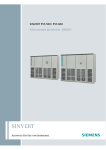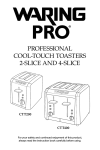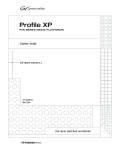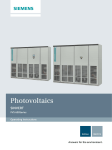Download Waring Pro PVS1000 Use and Care Manual
Transcript
The Pistol Vac PROFESSIONAL VACUUM SEALER SYSTEM PVS1000 Series For your safety and continued enjoyment of this product, always read the instruction book carefully before using. CONTENTS IMPORTANT SAFEGUARDS......................................................... 2 BATTERY AND CHARGING GUIDE.............................................. 3 PARTS AND ASSEMBLY............................................................... 4 OPERATING INSTRUCTIONS....................................................... 5 GUIDELINES FOR VACUUM SEALING ........................................ 6 PREPARING FOOD FOR THE FREEZER....................................... 7 GENERAL RULES FOR FOOD SAFETY........................................ 7 CLEANING, CARE AND MAINTENANCE...................................... 8 TROUBLESHOOTING................................................................... 9 IMPORTANT SAFEGUARDS When using electrical appliances, basic safety precautions should always be followed, including the following: Note: It is important to follow food safety guidelines when using The Pistol Vac Vacuum Sealer System. 1. This appliance is not for use by children. Close supervision is necessary when any appliance is used near children. 2. Do not operate any appliance with a damaged cord or plug, or after the appliance malfunctions or has been damaged in any manner. Return appliance to the nearest authorized service center for examination, repair or adjustment. 3.Do not attempt to open The Pistol Vac or charging stand, as there are no user-serviceable parts. 4.The use of attachments not recommended or sold by Waring may result in fire, electrical shock or injury. 5.To protect against electrical shock, do not immerse The Pistol Vac, charging stand or charger in water or other liquids. 6. Do not use outdoors or for other than intended use. 7.Do not place on or near a hot gas or electric burner or in a heated oven; to avoid battery leakage, overheating, smoking and/or other damages, do not put the appliance or charger in a microwave. 8.Do not vacuum seal objects with sharp points like fish bones and hard shells. Sharp points may penetrate and tear the bags. 9. Do not use bags to vacuum seal soups or other liquids. 10. Do not impact, vibrate or throw the appliance. 11.To avoid fire or other failure, do not use the appliance in a place with volatile gas. 2 12.To avoid degradation of its performance and loss of the battery life, do not store the appliance in a high temperature, high humidity, or dusty place. 13.This appliance is not intended for use by persons (including children) with reduced physical, sensory or mental capabilities, or lack of experience and knowledge, unless they have been given supervision or instruction concerning use of the appliance by a person responsible for their safety. 14.Do not operate your appliance in an appliance garage or under a wall cabinet. When storing in an appliance garage, always unplug the unit from the electrical outlet. Not doing so could create a risk of fire, especially if the appliance touches the walls of the garage or the door touches the unit as it closes. 15.When charging or storing the battery, if there is abnormal heating or deformation, you should stop use immediately. 16.If there is battery leakage or a strange odor, please keep away from fire. SAVE THESE INSTRUCTIONS For Household Use Only BATTERY AND CHARGING GUIDE This appliance is for 120 volts only and should not be used with a converter. 1. Before first use, charge the battery for 12 uninterrupted hours. LED light will turn green when the Pistol Vac is charged and ready to use. 2. Use the provided battery charger only to charge the unit. 3. To avoid short circuit, do not connect the terminals of the battery with the clips or electric wires. To prolong the battery life always store this appliance in a cool, dry place – away from sunlight – with a temperature under 77°F. 3 PARTS AND ASSEMBLY OPERATING INSTRUCTIONS 1. The Pistol Vac 1. Place food in bag (2) and close with the zip tool (3). 2. Bags (12 quart sized & 12 gallon sized)* 7 3. Zip tool When vacuum sealing foods that contain some liquid (i.e., chicken or marinated foods) seal the bag while it is in a vertical position. Do not lay it flat on a counter as liquid may interfere with the valve. (If liquid does get into the valve, follow the cleaning instructions on page 8.) 4.Valve 1 6 5.Trigger 6. Suction cup 7. Suction base 8. Inner suction nozzle 9. Charging stand 8 2.Position The Pistol Vac on the red valve (4) and pull the trigger (5) to remove air. 5 10. Charger (not shown) 3 4 2 9 4 The vacuum sealing process takes only seconds. If it is taking longer, it could mean that the bag has not been properly closed. Close fully using the zip tool, then resume pulling the trigger. Sealing is complete when The Pistol Vac begins to make a straining noise, signaling that all of the air has been removed. You will also see that the bag has shrunk tightly around the food. Press on the red valve after sealing is complete to ensure it is completely sealed. 2 3.Store bags in the refrigerator, freezer or cupboard to keep food fresher longer. Keep food in the proper storage place, following the food safety guidelines. If storing for a long period of time, it may be necessary to check to see if the vacuum seal is still completely tight. If not, use the sealer to remove any air that may have entered over time. *Additional bags can be purchased at your local retailer or online at waringpro.com. 4 5 GUIDELINES FOR VACUUM SEALING Preparing food for the Freezer 1.IT IS IMPORTANT TO FOLLOW FOOD SAFETY GUIDELINES WHILE USING THIS APPLIANCE. o vacuum seal unfrozen foods that will go in the freezer, leave T two extra inches of space to allow for expansion during freezing. 2.DO NOT overfill the bag; leave enough empty space for The Pistol Vac to come in contact with the valve. 3.Do not leave too much air inside the bag. Press bag to allow extra air to escape before closing and vacuum sealing it. 4.Do not vacuum seal objects with sharp points (i.e., fish bones or hard shells). Sharp points may penetrate and tear the bags. 5.Do not vacuum seal soft food items such as soft cheeses. 6.Do not use vacuum sealer system to store soups or other liquids. 7.During the sealing process, small amounts of liquids, crumbs or food particles can inadvertently enter into the suction cup, clogging the pump and potentially damaging your appliance. If this happens, immediately release the trigger and follow the cleaning instructions on page 8. To prevent this, follow these tips: a)For moist and juicy foods such as raw meats: Seal the bag closed while it is in a vertical position. You can also place a folded paper towel inside the top of bag to separate the food from the valve before vacuum sealing it. b) F or powdery or fine-grained foods: avoid overfilling bags. You can also place a paper towel inside before vacuum sealing it. NOTE: To avoid possible food-borne illness, be careful when reusing bags after storing raw meats, fish or greasy foods. efore storing foods such as tortillas, crêpes or hamburger B patties, use wax or parchment paper to separate them. This will make it easy to remove only the amount of food needed at a time. Re-seal the rest of the food immediately and replace in the freezer. GENERAL RULES FOR FOOD SAFETY • B egin with the freshest food possible. Vacuum sealing extends the life of foods by removing air from the bags that they are stored in. Removing air can also stop the growth of microorganisms, which under certain conditions can cause problems. Even under proper storage conditions, food may lose freshness if stored for too long. To preserve food safely, it is important to store food at low temperatures. • T o avoid any possible food-borne illness, wash bags thoroughly after storing raw meats, fish or greasy foods. Also try labeling the bags to keep track of food items that have been stored previously. • If perishable foods have been heated, defrosted or unrefrigerated, consume them immediately. • T he suitable way to defrost sealed food is to place it in the refrigerator until defrosted. Never defrost foods in hot water or a microwave oven. • If you open a previously vacuum-sealed bag and remove only some food, immediately re-vacuum seal the bag and store it in the proper place. COOK Boil or microwave right in the bag! The reusable bags are approved for freezing, boiling and microwaving. FDA approved for food contact, and BPA-free bags are food safe. (Cooking time varies.) 6 7 CLEANING, CARE AND MAINTENANCE TROUBLESHOOTING Always unplug the appliance before performing any cleaning and maintenance operations. NOTE: If the appliance has not been used for a long time, you will need to recharge it before use. NOTE: Be sure to wash all parts thoroughly to avoid foodborne illness. If nothing happens when you pull the trigger, you may need to do the following: 1.Rotate the suction cup to the unlock position and pull it outward to remove. Rinse the suction cup with warm soapy water. 2.The rubber inner suction nozzle is removable for cleaning. Wash with warm soapy water. 3.Clean The Pistol Vac and the suction base with a non-abrasive cloth. 4. Ensure that parts are completely dry before reassembling. 1. Be sure that the unit is charged. Cleaning the bags: Wash the bags with warm soapy water or place on the top rack of the dishwasher. NOTE: If you wish to reuse a bag after storing raw meats, it is important to be sure that bags have been completely sanitized in order to prevent food-borne illness. When sealing and storing raw meats, it is strongly recommended to discard bags after use if the valve comes in contact with liquids. 2. Be sure that the electric outlet is working properly. To properly sanitize the valve of the bag: 1.Pour a diluted bleach solution into the bag, dispersing evenly. 2. Empty the solution from the bag. 3.Use The Pistol Vac to suck the remaining liquid through the valve. Note: Only a small, weak bleach solution is needed. Do not suck any liquid into the inner suction nozzle, as that may damage the appliance. 4.Before using, thoroughly rinse the bag with clean water after the above operation to be sure all bleach has been removed. Any other servicing should be performed by an authorized service representative. Air is not removed from the bag completely: 8 2.Check the appliance parts to be sure that they are not loose. If they are loose, tighten them, and resume the sealing process. The unit will not charge: 1.Check that the unit is properly connected with the charging base so that the LED is illuminated. It does not work right after being charged: 1.Make sure the LED lights are illuminated during charging. If not, properly connect The Pistol Vac to the charging base so that the lights are illuminated. 2.If the LED indicator lights are on, make sure that The Pistol Vac has been charged long enough (9–12 hours for fully charged battery). 1.Bags are not sealed: re-align the zipper, and be sure the entire zipper is closed. 2.Make sure the valve is clean. You may need to replace the zip bag. 3. The bag is too full; reduce the amount of food to be sealed. 4. Extend the vacuum sealing time. 9 Notes 10 Notes 11 Trademarks or service marks of third parties used herein are the trademarks or service marks of their respective owners. ©2012 Waring Consumer Products 150 Milford Road East Windsor, NJ 08520 www.waringpro.com Printed in China PVS1000 IB 12WR129173 IB-11241























